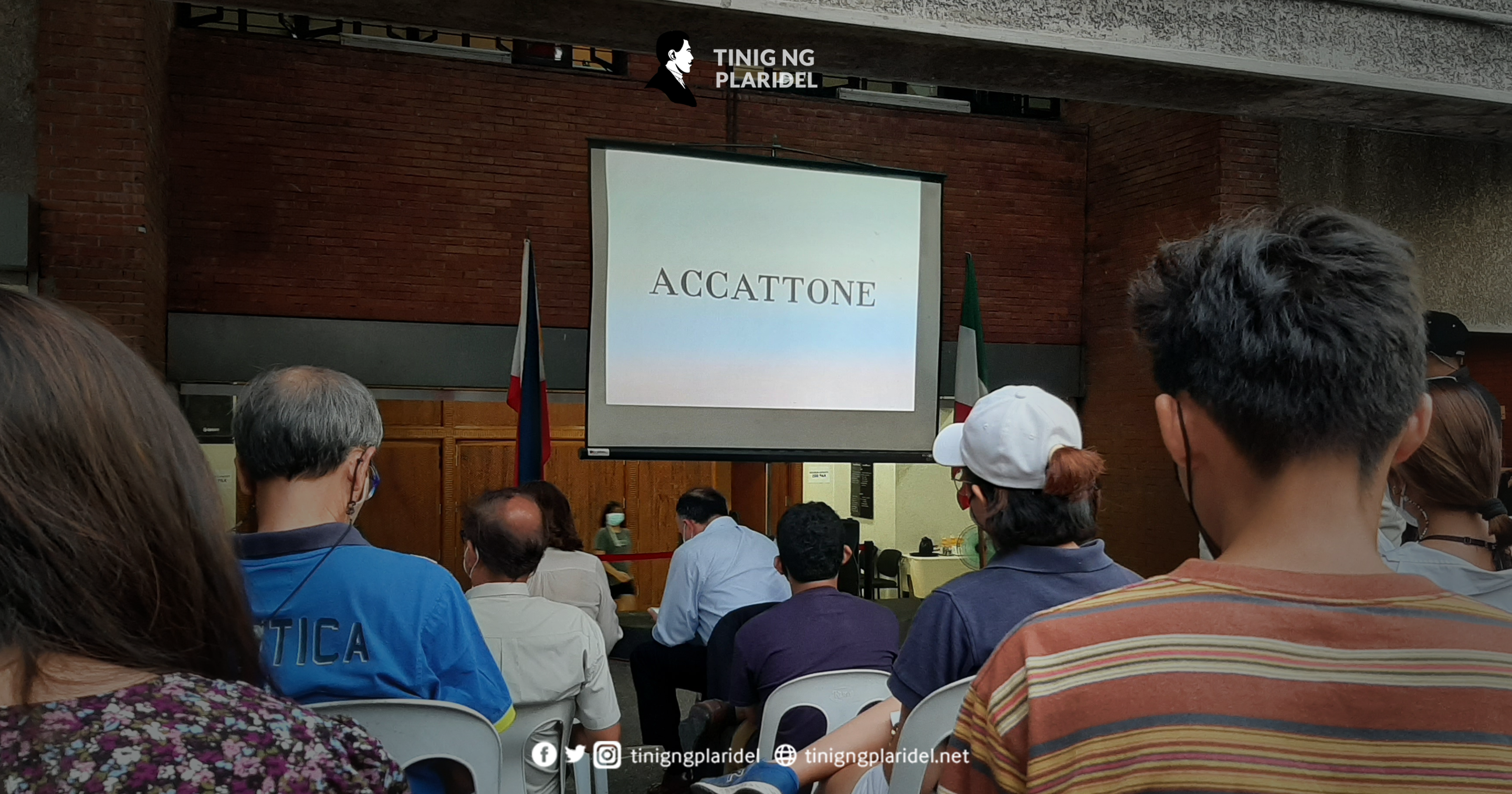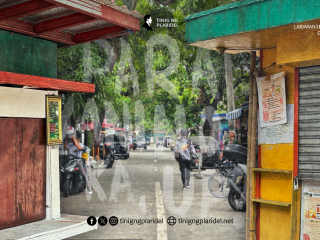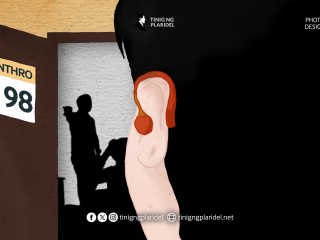DISCLAIMER: This review contains spoilers.
The crowd was neither dead nor raucous. Less than a hundred dedicated fully-vaccinated cinephiles gathered in what is usually the holding area in front of UP Cine Adarna. Monoblock chairs filled the small viewing space. Rain loomed over. There were no popcorn stalls.
It was the theater’s first on-site screening two years after the COVID-19 pandemic bogged down cinema gatherings nationwide. For some, it was a miracle that Cine Adarna’s marquee no longer displayed the words “suspended until further notice.”
Held on May 21, this outdoor cinema, aided by the Italian Embassy in Manila and the Philippine Italian Association, marked the centennial of Italian filmmaker and poet Pier Paolo Pasolini. It seemed fitting that the event also screened the auteur’s two-hour 1961 debut feature “Accattone.”
Filipino filmmaker and film historian Nick Deocampo preceded the screening with a 30-minute talk on how the director, whom he called “the unconscious impulse of my matured life,” shaped his choice of cinema – the aesthetics and homoeroticism visible in Deocampo’s seminal documentary film “Oliver.”
Incidentally, it was my first foray into Pasolini’s corpus of work. I was elated at first. But in setups like this, it would only take a minute to disrupt one’s viewing experience, and that disruption diluted whatever potential “Accattone” and its 4k restoration had to offer.
Shot in austere black and white, the film follows the anti-heroic Vittorio “Accattone” Cataldi (Franco Citti), who lives off others as a pimp and thief. But when his sex worker Maddalena (Silvana Corsini) sustains a leg injury, he struggles to make ends meet.
He returns to his estranged wife Ascenza (Paola Guidi), scrounging for food but to no avail. Then he tries to recruit the charming Stella (Franca Pasut) as his new sex worker after their meeting. Accattone is, as one might venture to say, a spitting image of male chauvinism and toxic machismo.
The “following” in the film can be taken quite literally as Pasolini heavily employs tracking and horizontal panning shots that situate the lead character and his audience in a Rome marred by poverty and criminality, accenting the film’s zeitgeist.
From a Marxist lens, this material condition warrants the unscrupulous decisions and actions of every character in the film. “But what’s hunger, really? A bad habit! It’s all in the mind,” blurted Accattone.
But later on, we see him devising a ploy to screw his starving friends over to solo a plate of pasta they were supposed to share. This scene tells us how, at some point, logic can be rendered immaterial by hunger.
Contrary to Deocampo’s reading, the homoeroticism that would later define Pasolini’s cinema was not as explicit in “Accattone,” even as male bodies were often displayed, especially in the first half. The film is more a study of the Italian proletariat than of carnal relationships between people of the same sex.
Moreover, the director’s economical use of real locations, non-professional actors and choice of subject matter lend the film its neorealist qualities. The way Accattone wanders through the slums is reminiscent of Vittorio De Sica’s “Bicycle Thieves,” limning how Pasolini is always conscious of space and background.
But this wandering was the last thing I could recall for the screening’s entirety. Thirty minutes in, my friend and I found ourselves fending off flying termites, the local gamu-gamo, which swarmed the viewing area. It’s as if these creatures collectively decided to steal everyone’s attention like an unhinged diva.
It was enough for a viewer behind us to walk out. Moments later, I had to leave my seat as the termites began squirming through my garments. By the time huge electric fans were out, the damage had been done. After calming myself down, I sat on the side where the film was being projected and endured the whole thing until the credits rolled.
The ordeal could have been avoided had Cine Adarna opened its doors to its 800-seater cinema. I had no choice but to revisit the film at home and settle for a smaller screen.
The second viewing offered illumination and closer inspection of what made “Accattone” controversial at the time it was released. In fact, Pasolini’s mentor and Italian master Federico Fellini pulled out his support for the film after seeing some test footage.
Is it because Pasolini didn’t strictly adhere to the Italian neorealist canon as he refused the “styleless” editing style and employed a Bach musical score? Or is it because the auteur upheld both the sacrosanct and the profane by depicting Accattone as a Christ-figure but also nuancing his immoral idiosyncrasies, hence the inversion of the Catholic dogma dominant in the 1960s? These points merit a deeper – and separate – discussion.
However, what provoked and left me aghast in “Accattone” was how Pasolini portrayed women and their bodies as if their raison d’être is solely to become men’s sources of pleasure, devoid of humanity.
The female characters were often depicted in dark alleys and dangerous corners; their conversations replete with the fixation to remain young and beautiful; their layers reduced to grains of sand. But Pasolini is not afraid to run that risk, so as to give the impression of significance.
In the film’s earlier parts, we witnessed how Maddalena had been assaulted and abandoned by a gang of thugs in a grotty field. This could not have happened had Accattone not forced her to work despite her broken leg. Yet, Maddalena defended the pimp before the police.
In another scene, Accattone says he’s enamored with Stella because she’s “different, helpless, alone” and that all she needs is “some comfort.” We even find the woman carrying remorse because she cannot stomach whoring her body.
It seems like the lead male character’s nuances are only attained at the expense of his female counterparts. The women exist only because they have to play a part to move the story forward. It’s no surprise that the film miserably fails the Bechdel Test, a measure of how women are represented in cinema.
But could the precarious state of the entire community in “Accattone” have excused the gnawing misogyny of its male characters? One might argue otherwise.
Even Accattone’s sense of change hinges on the need to take care of Stella. So, to keep his promise, he resorts to thievery. When the authorities chase him, he steals a motorcycle and escapes, only to meet a fatal end. Does it count as salvation because he no longer wants to exploit a woman? Barely. Does Pasolini want us to root for this self-absorbed man? Somehow.
Yet, the protagonist’s death is more than a case of bad karma. In a sense, Pasolini implores us to contemplate what has brought Accattone to such a condition, evoking a larger commentary on capitalism’s brutal nature, while keeping one’s agency in perspective. We then begin to understand how those forced to live on the fringes of society can be acclimated to a cruel system that continues to disempower them, to the extent that people end up taking advantage of each other. What choice do they have?
This is why the film hardly feels empowering. However, as the impetus of this review conveys, this rich subtext is subdued by a rather wearying moviegoing encounter. It would not have been possible for this insight to materialize were it not for the second viewing.
In hindsight, this defeated the outdoor cinema’s purpose. Of course, one cannot deny how difficult it is to mount initiatives like this given the logistics and costs of on-site screenings. It only goes to show that a film’s value is just as important as how and where it is being shown.
For what it’s worth, I’m still glad to have seen local cinema slowly pick itself up and return to the art form amid a rapidly changing virus.
As for this showing, when the screen fades to black, the viewing experience ends where it begins: middling.









